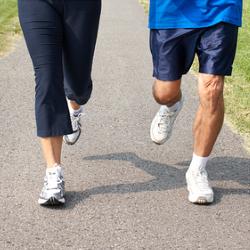We know that walking at a brisk pace (at least 3 mile per hour) is not only good cardio exercise, but it can help you lose weight. However when combined with other types of cardio exercising, such as water sports, biking and weight training, you can achieve your weight loss goal quicker.
Water Sports and Walking
If you have bad knees, swimming and water aerobics may be ideal forms of cardio training for you. Not only are they low-to-no-impact exercises, they work your heart, lungs and many different muscle groups very effectively. When swimming, use various types of strokes to work different muscle groups and get the maximum upper and lower body benefit. If you enjoy doing water aerobics, add water weights to get even more benefit from your water training routines.
Biking and Walking
Biking is another low impact cardio exercise that is good for weight loss. Not only does it work the larger lower body muscle groups for maximum calorie burn, it builds up those same muscles so they burn more calories even when not exercising.
Anything you can do to make an exercise harder to do or to build muscle will burn more calories. When biking, go faster or further. Instead of biking with the wind, choose to go against it; on a varied course, go the direction that gives you the most uphill rides. You’ll get better workouts and burn more calories.
Weight Training While Walking
To increase the effectiveness of walking, use either light wrist or ankle weights (or both for maximum calorie burn). Walking while wearing just one pound weights will significantly increase the number of calories you burn.
Because walking and biking tend to specifically work the lower body muscle groups, consider adding in a couple days per week of upper body weight training per week to push your weight loss to the next level. You can use dumbbells, free weights or kettlebells; all tend to work your upper body, thus defining and toning those muscle groups. And if you are female, don’t worry about “bulking up”; it just won’t happen because you do not have the necessary level of testosterone needed to build huge muscles.
Each exercise by itself has limitations as far as how much each can affect weight loss, but by combining them, you can burn more calories during each workout and achieve your weight loss goal quicker. Once at goal, keep walking and doing these exercises at a lesser intensity to maintain your weight loss.
If you’d like to get more out of your walking for fitness plan, check out the “Guide to Setting Your Walking Fitness Goals” for more in depth knowledge on the subject of walking for fitness. While you’re there, be sure to sign up for the free MyFitnessNut.com Newsletter to be kept up to date on the latest health and fitness topics.









